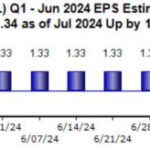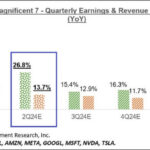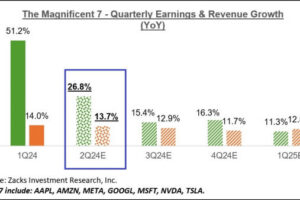On today’s episode of Asking for a Trend, Yahoo Finance’s Julie Hyman breaks down the trading week’s major stories and what to watch next week.
Nvidia (NVDA) executed a 10-for-1 stock split after Friday’s market close, which comes after the chip giant surpassed a $3 trillion market cap. Bespoke Investment Group co-founder Paul Hickey calls Nvidia’s recent run “unlike anything we’ve ever seen,” and adds that the company has what seems like an “insurmountable lead” in the current AI landscape.
Akiko Fujita takes a closer look at how rocks are being used to help companies reach their net-zero targets.
Finally, Julie Hyman breaks down what investors should expect next week, from the Federal Reserve’s interest rate decision to Apple’s Worldwide Developer Conference.
This post was written by Melanie Riehl
Video Transcript
Hello and welcome to asking for a trend.
I’m Julie Hyman in for Josh left in and for the next half hour will be breaking down the trends of today that will move stocks tomorrow.
Here are some of the trends will be diving into what cool down the US has far more jobs than expected in May bucking fears of a labor market slowdown and pushing out expectations of rate cuts.
What goes up must come down game stop plunging roughly 40% after investor Keith Gill, a war kitty takes to youtube for the first time in years to reiterate his support gamestop and its Ceo Brian Cohen and let them buy shares in video.
10 for one stock play will slash the cost per share for the chip maker giant starting Monday and open the door for more retail investors to potentially buy into the A I NVIDIA executing that 10 for one stock split after the close today with the stock closing at about $1209.
So shares will begin trading on a split adjusted basis when the markets open back up on Monday.
For more on what this means to investors and the A I trade broadly or bring in Paul Hickey, co founder of Bespoke Investment Group.
Hey, Paul, good to see you.
You too.
How are you doing?
I’m doing.
Oh, great.
Thank you.
This has been a fun story to watch the NVIDIA story that is with the, the stock split being the latest, um, news there along with the earnings.
Um, and I know you’ve, you’ve written a lot and thought a lot and looked a lot at the trading patterns that we have seen in NVIDIA.
So as we now factor in the stock split, what does that do to sort of your view on the, on the whole phenomenon?
You know, I, I don’t think the stock split is much of a big deal.
I mean, yes, it, it, it allows retail investors to buy shares of it.
Um You know, it’s hard, it’s a lot easier to buy $100 stock than $1000 stock.
And while brokerages have fractional shares, it never sounds good to say, hey, I bought 1/10 of a share of NVIDIA.
So I, I think in that respect, psychologically, it, it’s a good thing there.
Uh This run that we’ve seen though is just unlike anything we’ve ever seen, you know, like you, you go back to all these comparisons just, I mean, we just think about the last year with NVIDIA, it went from one trillion to two trillion market cap in nine months and then went from two trillion to three trillion in about three months.
So in just the span of a year, it’s added two trillion in market cap, which is more than Amazon is like the entire market value of Amazon.
So that, that kind of run is just insane.
It’s up 22,000% over the last 10 years.
And if you look at all the other mega caps today uh over any 10 year period in their history, um Microsoft is the next closest as it went up, about 13,000% in the, in the nineties.
So this is this kind of move is unlike, you know, pretty much anything you’ve seen amongst current market, current mega caps.
Uh you know, but it sort of reminds me, you know, if you remember back to the late nineties and Cisco, the run in Cisco, Cisco had a was in a very similar position in the internet um as NVIDIA is within the A I space today.
So, um that’s something to keep, keep in mind.
And when we look, when we did a comparison of Cisco following the IP O of AOL in the early nineties, you know, which was a seminal moment in the early days of the internet.
And if you compare that to how NVIDIA has done since 2016, when Google versus Sundar Pachay said that we’re now an A I first company.
So that was a seminal moment in A I and you compare the runs of those stuff over those periods, they’re nearly the exact same up until this year.
Here, here’s my question about that, Paul when Cisco had that run, what was its pe Right.
So, I mean, to me that’s been one of the most interesting things about NVIDIA is that even as the stock has skyrocketed rocketed because the earnings are kind of keeping pace here, the price to earnings ratio has not gone crazy.
Oh, no, you, you’re, you’re absolutely right.
And so I wouldn’t say that NVIDIA has to crash from here by any uh any stretch of the imagination.
But what this stock has done is it’s to keep that growth pace, growth pace going forward.
It’s just the, the, the numbers are just, you know, become too high and it’s just, just takes up, you know, all of the other market cap of um of the companies in the market.
So I think it’s just, it’s an unsustainable pace.
But the key is to remember is back in the nineties, Cisco had the monopoly on routers, there were other networking companies.
But if you really wanted to build out your network, internet infrastructure, you had to use Cisco products today.
If you want to build out A I, you have to use NVIDIA chips.
And so at both Cisco at that time and NVIDIA now they have what seems like insurmountable leads.
But at some point, the comp you know, competition um you know, comes into the market.
Success breeds more competition.
And, uh, I think over time you’ll see that again.
I don’t think NVIDIA is a stock that’s gonna go crashing and burning from here by any stretch of the imagination.
But a lot of the move and the positive fundamentals have been priced into the stock at this point.
Yes.
And it’s important to keep that history in mind as well.
Speaking of history, more recent history, um, we’ve got the return of 2021 with the meme stock situation.
And I don’t know if you watched the Keith Gill Live Stream today where he, he was just kind of hanging out talking about gamestop and also trying to get people to guess what kind of beer he was drinking.
Um, Paul, I’m just curious what, what you make of this, especially, you know, whether we’re seeing some parallels with what we saw in 2021.
So, I mean, I don’t think it’s as widespread now as it was in 2021 in 2021 stocks, all these short, heavily shorted stocks were just going bananas.
It wasn’t just Gamestop.
Uh, now it looks more isolated, but Gamestop today, the volume was higher than I think you have to go back to March 2021.
Uh, to find the last time its volume was this high.
I mean, I think, you know, there’s, there’s a lot better ways to waste your money as an investor than to uh, try and, and, and ride that stock.
But, um, you know, I, I think it’s much more contained and it’s a, you know, what’s the market cap now today?
After today’s move it’s maybe like six or 7 billion.
So it’s, it’s, I mean, that’s like, that’s like, uh, 10 cents in NVIDIA stock right now.
So, it’s, it’s, um, it, it’s very contained and I, I don’t, I think it’s a broader market issue to worry about at this point.
Game stops.
Uh market cap $9.9 billion believe it or not even after today, even after today.
So I can only imagine what it was yesterday if that’s right.
Maybe that’s not the closing.
Maybe that hasn’t been updated for the close.
We’ll get that number, Paul.
It’s great to see you in any case.
Have a great weekend.
Have a good one.
Take care.
Thanks.
Coming up an encore showing of our latest episode of next.
All about the big business of carbon removal that is next on asking for a trend, rapid advancement in A I has accelerated energy usage for tech companies.
That’s what the importance of carbon removal technologies in focus.
Our Kiko Fujita takes a closer look in this encore presentation of next.
So the first thing we’re gonna do is turn our spinner blades on.
You can already see a streak where we’ve already spread out there.
Rick Bennett is a third generation farmer trying his hand at a new type of fertilizer crossed volcanic rock known as the salt.
The rock dust is considered waste but one start up is finding new use for it to tackle a climate crisis.
Workers here affectionately call this Brown Mountain lithos carbon considers it gold.
This material is what’s chemically reacting with carbon dioxide to permanently capture and sequester it into a form that takes it out of the atmosphere.
It’s a process that happens naturally Over thousands of years, lithos carbon is spreading it on farms to accelerate it to two years backed by a $57 million investment from frontier, a consortium of companies that includes Meta and JP Morgan.
There are some portions of company emissions that you will just never abate.
Recognizing that they have a net zero target and they want to actually get to zero in honor very public commitments.
They have to invest in some sort of removal.
Technology scientists say it’s not enough to reduce carbon emissions but capture them with co 21 of the leading causes of climate change, which is why hundreds of companies are pouring into the carbon removal space.
The question is which can scale up quickly cheaply with the future of our environment at stake.
This is what’s next in carbon removal.
We’ve got drill rigs prepping for the next shot.
We’ve got blasters in here, loading for a shot.
This quarry is so busy.
Uh We blast a couple times a week out here and that could drop 50 to 60,000 tons of rock at a time onto the ground.
How far down are we?
Right now?
We’re about 100 ft down in this active pit state of North Carolina.
We can mine down to 500 ft deep.
So we’re gonna be here a very long time.
Mining.
The, this fight against climate change begins with one of the most abundant resources on the planet.
Basalt has long been considered the building blocks used in asphalt and concrete.
Some rock quarry in North Carolina has so much of it.
It ships out millions of tons every year.
We take that 36 inch boulder and we crush it down to sand size particles that we can put the asphalt and concrete.
And from that surge pile, it’ll get crushed again, it’ll get screened, it’ll get washed and it’ll kind of continue on that process until it gets to a final product size and spec and stockpiled.
Some rock uses every piece of that rock except the dust of waste that piles up in the end.
This is the secret.
This is what we looked all over the country for.
Is this this particular material?
Not all the salt is quality that lithos wants.
Can you tell by just looking at it or do you actually have to?
You can’t.
Yeah.
So if we look at it under an electron microscope, we’re looking at all the properties that make it suitable for the carbon capture process and also release the nutrients that helps the soil and the plants grow in it as well.
It’s part of a process called enhanced rock weathering carbon dioxide in the atmosphere combines with rainwater to create a weak form of acid rain that rain hits volcanic rocks.
It leads to a chemical reaction that traps CO2.
It’s a natural process that takes thousands of years.
Lithos carbon is speeding that up more than 1000 times by spreading the finest form of rock dust across farm fields.
The thinking is the more surface area, the rocks cover, the more carbon is captured.
Li says all of the rain combined with the salt also helps improve crop yields.
Farms are extra special and extra powerful for a few reasons.
One the roots, they break up the rock dust faster.
So that’s great to the farmers already need to spread rock dust in their field.
They need to do this to rehabilitate their soils.
After we use synthetic Fizer, the farmers, they’re already spreading rock that we’re actually replacing something they already do today with something that works even better.
So it’s plugging into existing infrastructure, piggy backing on that and allowing us to scale this climate crisis faster.
So the drill goes in, it pulls the dirt right up into the bucket.
The soil is manually tested every two acres every six months to measure the amount of carbon captured enhanced rock weathering is one of many solutions in a growing industry with demand projected to quadruple from 2030 to 2040.
According to consulting firm BC G, there are already more than 220 carbon removal companies globally.
There’s multiple different pathways, chemical pathways for which you can take co two out of air and no one really knows for sure yet which ones are going to be able to scale the fastest and come down the price curve most effectively.
And so it really starts to become a complicated puzzle of which technologies work in the right atmospheres or in the right environments to optimize all of this.
And we need some of all of them, this satellite image of carbon in the atmosphere points to the scale of the problem.
Humans have dumped two trillion tons of CO2 into the air pushing global temperatures more than two degrees above pre industrial levels.
The UN panel on climate change says we need to remove up to 10 billion tons per year by 2050 to avoid the worst impacts of climate change.
That amounts to roughly 25% of annual carbon emissions today that many of those emissions will be eliminated through various reduction measures.
So more efficient motors, cleaner power, etcetera.
But there is still a large amount of emissions that ultimately will have to be taken out of the atmosphere in some way.
If we want to get to net zero, that’s where carbon removal comes in.
Even with all of the efforts to decarbonize bcgs.
Current mystery estimates, companies will still fall more than 30% short of their goal to be truly net zero.
That means they will need to buy carbon credits from companies like lithos to offset emissions, they can’t reduce on their own.
I think all of these sort of front runners in the carbon market, they’re not just interested in what they can buy today.
They are investing in the future of the carbon di removed market.
The scale of the problem, they recognize that investment is needed.
So they are looking to kind of support pathways.
There are a lot of ways to remove carbon, but there’s a trade off between affordability and reliability.
Direct air capture has the simplest measuring system, but it requires building large factories that can suck co two out of the air.
It costs up to $1000 to capture a ton of carbon methods that rely on agricultural waste are considered cheaper, but it requires a lot of land enhanced rock weathering uses a smaller footprint.
But critics say there’s too much uncertainty, there isn’t enough data to show how effective the process is planting trees may be economical.
But misri says the carbon storage isn’t as permanent precise measurements are harder to come by.
You can estimate how much carbon is in the tree.
But there are questions like what happens if it gets cut down, what happens if there’s a forest fire?
And so in all of these technologies, they all have various pros and cons.
But in general, the higher quality ones or the higher durability ones are the ones that are closer to I can touch and feel and I can see this much has been removed and someone can put a stamp on it.
Another question related to that is what is the relative value or quality of the different credits?
Right.
Buyers want to have confidence that they are purchasing actual carbon that’s been removed.
They don’t want to purchase something and then find out they didn’t actually remove on their behalf.
It’s a big reason why companies with the most aggressive climate commitments are backing new technologies.
BC G estimates this market could reach as high as $135 billion by 2040 BC GS invested its own money signing partnerships with direct air capture companies like CLIM works to remove more than 140,000 tons of co two combined from the atmosphere.
Companies from alphabet to JP Morgan have invested more than $57 million in lithos as part of a consortium known as Frontier.
The funds agreed to buy 100 54,000 tons of carbon from lithos in the next few years.
Combined frontiers committed to buying nearly a billion dollars of carbon.
By the end of the decade, we are moving so much material that anything that we can do to optimize the movement of that helps.
So part of these large optic agreements.
What they allow us to do is start leveraging more efficient methods of transportation like rail or like barge.
Those methods can be extremely, extremely efficient but you need to move a lot more minimum volume to get there.
Impact is still hard to quantify though companies are required to measure and verify carbon credits that are sold.
One of the most important things is that clear MRV, the monitoring reporting and verification, if you can clearly articulate and, and prove that you have captured a ton when you say you’ve captured a ton, but there’s not a universal standard right now.
Correct.
That’s correct.
And it gets really tricky when you start to look at different technologies with enhanced rock weathering, you basically, you take rocks, you scatter them and these rocks will absorb co two and in these situations where you have the capture occurring over, it could be acres, it could be thousands of acres.
You can’t possibly measure every single rock, right?
So how do you sample it?
And up with an agreed upon number, that is the removal that can then be sold.
Soil samples can point to the amount of co two captured on farms, but that carbon doesn’t stay locked up until it makes its way to the ocean where it’s sealed off for good.
So what you actually measure here is not necessarily ultimately what becomes the credit.
That’s correct.
Yeah, this is of the initial step in the process, right?
What we’re measuring here is exactly how fast a rock is dissolving in the field, how much carbon dioxide that is pulling down.
And then we look at all the downstream effects, we call it kind of like a trade to grave accounting, right?
So we look at the effects here, we look at what’s happening in the rivers.
We also even model what’s happening in the oceans.
We take all of that into account before we kind of say, hey, here’s, here’s a ton of carbon that we’ve captured.
We’re doing custom application here.
Uh We’re actually applying um basalt and material here for another farmer.
Farmers like Rick Bennett are keeping a close eye on their fields.
Litho says the tiny rocks are helping improve crop yields by up to 57%.
In addition to handling and paying for every step of the process.
Lithos pays him, farmers get $50 an acre as part of the program.
What’s the result then?
From a yield perspective, has it actually improved the quality of the soil?
Has it improved your yield?
We have only had one season with it on the land.
We truly in our test didn’t see a yield increase last year, but we also did not lose any ground on our yield from the previous year.
So we’re excited to measure the results again this year, we think there will be definitely a yield increase.
Lithos expects to capture up to 50,000 tons of co two on farms this year, hundreds of other farmers are waiting to partner with the company, but they’ll need to scale much more than that with demand for carbon credits, far outpacing existing supply in the market.
Our goal is in the next 3 to 4 years to get as much data as possible that allow us to go the full way models that allow us to say, hey, we know the soil types, you know the crop types, we know the climate, we see ourselves building something like the Google maps of enhanced weathering from there being able to scale down our measurement cost that really, really the whole lion’s share of profits at the moment scale down this cost, reach more farmers faster scale this up for society.
The need is so great, right?
We are at the kill a ton scale today, we need to get to the gig Aon scale in the future.
That is a factor of a million growth today.
CD R is an optional thing and it’s starting to change.
But until it becomes required, it’s only going to be limited to those who are willing to do it voluntarily.
The only way we can scale the the technologies as fast as we need is if many of them succeed.
So this isn’t I need deck and not trees.
This isn’t I need enhanced rock weathering and not biochar.
This is I need all of it and I need all of them to scale the eu and the US have proposed guidelines to scrutinize the quality of carbon credits in the voluntary market.
But mystery says mandating offsets are critical to bringing costs down a necessary step to getting companies to their net zero goals.
Lithos currently charges $370 a ton.
The goal is to slash that to 100.
So our goal is to be capturing billions of tons of carbon dioxide using enhanced rock weathering.
We know that’s possible.
Our goal is to really be at maybe 2 to 6 billion tons worldwide.
How many farms you need to spread this across?
How many acres of you need to cover to get to that goal.
Not even all of the world’s farming land is actually just a fraction of it.
So in America, if we just focus alone on corn and soybean crops and there’s many other things we grow, obviously.
But if we just focus on that alone, we believe we could capture up to 0.7 gigatons, so 700 million tons of carbon dioxide.
So that’s the key time now for what to watch next week on Monday, all eyes will be on Apple, the tech giant hosting its worldwide developers conference where investors and consumers will get the first look at Apple’s A I strategy.
The company is expected to lay out details as it lags behind the competition in the A I space.
Also on Monday in video shares will start trading on a split adjusted basis.
The company completing a 10 for one stock split Friday.
After the meantime, the economy will be in focus on Wednesday.
In particular, the Federal Reserve decision is coming and while no rate cut is expected, we will be getting an updated dot plot that JP will hold a news conference at 2:30 p.m. Eastern.
But ahead of the fed decision will get CP I print for May.
The economy is forecasting core CP I the consumer price index to come in at 0.3% on the earnings front tech and focus with Oracle Broadcom and Adobe all on deck.
And finally the fate of Elon Musk’s $56 billion pay package will be decided.
Shareholders will vote on the controversial plan at Thursday’s shareholder meeting.
That’s wrap on today’s asking for a trend.
Be sure to come back Monday at 4:30 p.m. Eastern.
Have a great weekend.
















Add Comment